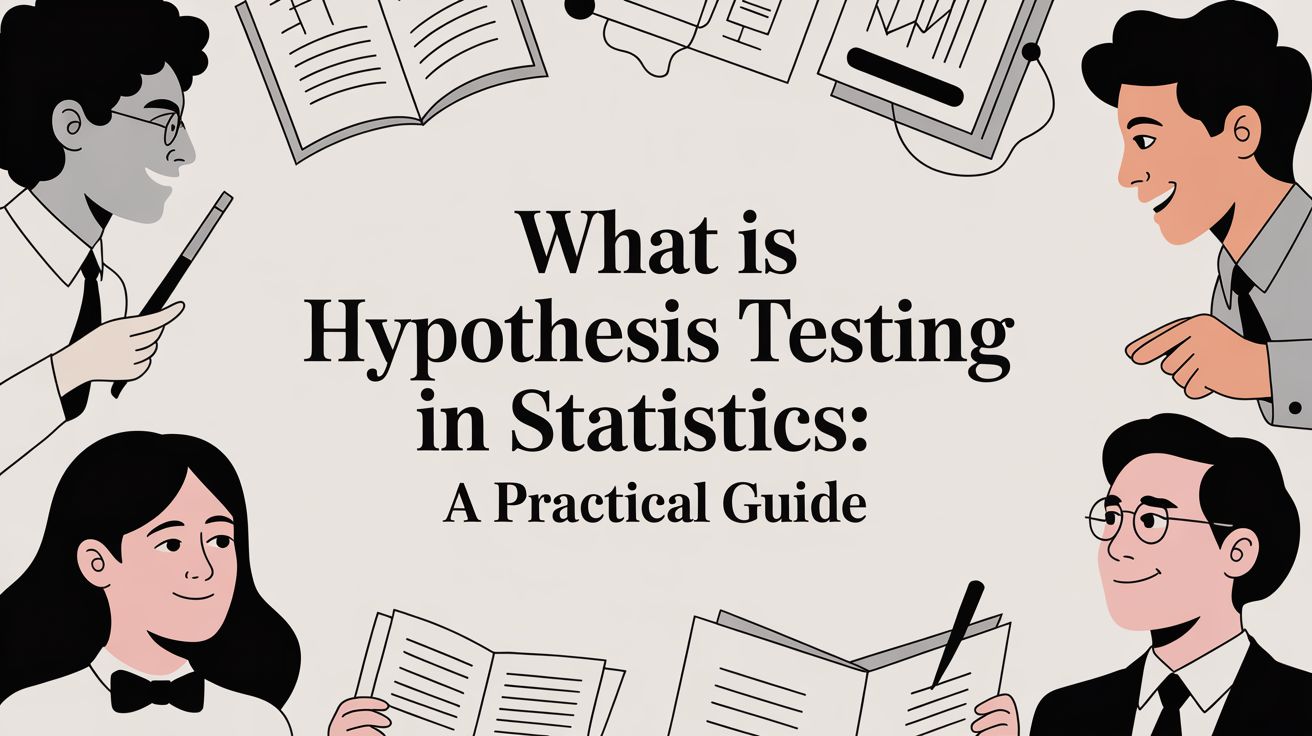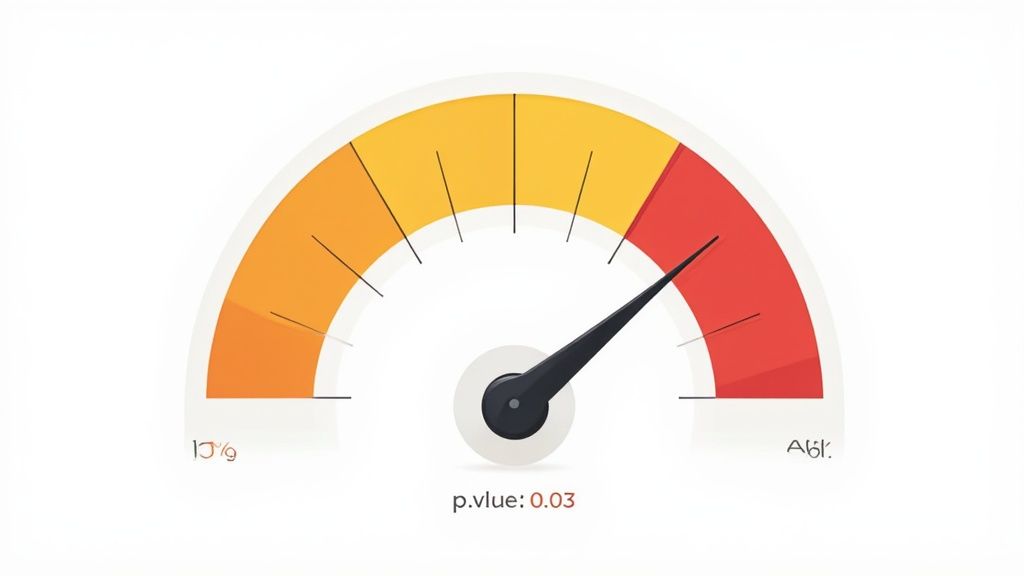What is hypothesis testing in statistics: A Practical Guide
Discover what is hypothesis testing in statistics and how it works, with clear steps, core concepts, and practical examples to draw valid conclusions from data.

So, what exactly is hypothesis testing? In the world of statistics, it’s our formal process for checking if a claim about a whole population is true, just by looking at a small sample of it.
Think of it as a structured investigation. It helps us figure out if something we've observed in our data is a real, meaningful effect or if it just happened by pure luck. It's the mathematical toolkit we use to make confident decisions based on evidence, not just a gut feeling.
The Detective Work of Data Science

At its heart, hypothesis testing is a lot like being a data detective. You start with a hunch or a theory—a claim you want to investigate. But instead of just going with your intuition, you gather data as evidence to see if that claim can withstand some serious scrutiny.
Let’s say a pharmaceutical company creates a new drug they believe shortens recovery time from an illness. It’s impossible to test it on every single person who gets sick. So, they give it to a smaller, representative sample of patients. Hypothesis testing is the formal procedure that allows them to analyze the results from that small group and make a reliable decision about whether the drug works for all patients. It’s what separates a lucky guess from a scientifically-backed conclusion.
A Courtroom for Your Ideas
One of the best ways to think about hypothesis testing is to compare it to a courtroom trial. In court, the defendant is always presumed innocent until proven guilty. Hypothesis testing treats your ideas the same way.
- The Presumption of Innocence: We start with a default assumption called the null hypothesis. This is the "nothing is happening" scenario. For our drug company, the null hypothesis would be, "The new drug has no effect on recovery time."
- The Prosecution's Claim: The idea you're trying to prove is called the alternative hypothesis. This is the claim that there is an effect. Here, it would be, "The new drug reduces recovery time."
- The Evidence: Your sample data is the evidence you present to the court.
- The Verdict: After analyzing the evidence, you make a decision. You either "reject the null hypothesis" (like finding a defendant guilty) or you "fail to reject the null hypothesis" (meaning there wasn't enough evidence to convict).
This careful, methodical approach keeps us from getting fooled by random noise in our data and jumping to the wrong conclusions.
This formal process has deep roots, tracing back to the early 20th century. Statisticians like Karl Pearson and Ronald Fisher were the pioneers who laid the logical groundwork we still rely on today. You can read more about the history of hypothesis testing and its development.
Ultimately, hypothesis testing is an essential tool for making objective, data-driven decisions. You’ll find it everywhere—from clinical trials and marketing A/B tests to factory quality control—giving us a reliable way to validate claims and push innovation forward.
Understanding the Core Components of a Test
Before you can run a statistical test, you have to set the rules of the game. Every single hypothesis test is built on a few key components that give your analysis a clear, logical structure. Getting these pieces right from the start is absolutely crucial—they define what you're testing and what standard of proof you need to meet.
Think of it like a courtroom trial. Before the lawyers start arguing, everyone agrees on the charge, the presumption of innocence, and what constitutes "proof beyond a reasonable doubt." In statistics, this setup makes sure our conclusions are objective and based on evidence, not just a gut feeling.
The Two Competing Stories: Null vs. Alternative
At the heart of every test are two competing statements: the null hypothesis and the alternative hypothesis. Your data will act as the evidence to decide which story is more believable.
The Null Hypothesis (H₀) is the default position. It represents the status quo—the idea that nothing interesting is happening and any patterns you see are just random noise. This is the claim you're trying to find evidence against.
The Alternative Hypothesis (Hₐ or H₁) is your theory or the new idea you want to prove. It's the claim that there is a real effect or a genuine difference, and what you’re seeing in the data isn't just a fluke. This is the hypothesis that carries the burden of proof.
Let's make this real. Imagine you've developed a new study technique and you want to see if it actually boosts exam scores.
- H₀: The new study method has no effect. The average score for students using it is the same as the average for students using the old method.
- Hₐ: The new study method improves scores. The average score for students using it is higher than the average for the old method.
See how they're direct opposites? They can't both be true. Your job is to collect the data and see which one holds up better under scrutiny.
To help clarify the distinct roles these two hypotheses play, let’s break them down side-by-side.
Null Hypothesis vs Alternative Hypothesis
| Concept | Null Hypothesis (H₀) | Alternative Hypothesis (Hₐ) |
|---|---|---|
| The Core Idea | Assumes the "status quo" or no effect. | Claims there is a real, significant effect. |
| Role in the Test | The baseline assumption you try to disprove. | The new theory you're hoping to prove. |
| Burden of Proof | Doesn't need to be proven; it's assumed true. | Requires strong evidence to be accepted. |
| Symbolic Form | Usually contains an equals sign (=, ≤, or ≥). | Contains an inequality (≠, >, or <). |
| Example | The new drug has no effect on recovery time. | The new drug reduces recovery time. |
Ultimately, these two hypotheses frame the central question your test is designed to answer.
Setting Your Standard of Proof
Once you have your two competing stories, you need to decide how much evidence it will take to convince you. This is where the significance level, also known as alpha (α), comes in. It’s your pre-determined threshold for rejecting the null hypothesis.
Essentially, alpha is the amount of risk you're willing to accept of being wrong in a very specific way—concluding there is an effect when, in reality, there isn't one. This is called a Type I error.
By far, the most common alpha level used in research and industry is α = 0.05. This means you accept a 5% chance that you might mistakenly reject the null hypothesis. It sets a reasonably high bar for your evidence.
If your test results have less than a 5% probability of happening by random chance, you can call them "statistically significant." This doesn't mean the null hypothesis is impossible, just that it's highly unlikely given your data. Choosing a stricter alpha, like 0.01 (1%), means you demand even stronger, more convincing evidence before you're willing to believe the alternative story.
Decoding Test Statistics and P-Values

Once you’ve laid out your hypotheses and picked a significance level, it’s time to dig into the evidence. This is where two of the most crucial concepts in hypothesis testing show up: the test statistic and the p-value. These numbers are a team, working together to measure just how strong your sample evidence is when pitted against the null hypothesis.
Think of it like this: your sample data is telling a story. The test statistic and p-value are what translate that story into a clear, mathematical verdict, helping you figure out if your findings are truly meaningful or just a fluke.
The Test Statistic: Your "Surprise Meter"
The test statistic is a single number that boils all of your sample data down into one standardized value. Its entire purpose is to show you just how far your sample results stray from what the null hypothesis predicted would happen.
Imagine the null hypothesis is "zero" on a number line—the point of no effect. The test statistic simply measures how many standard deviations away from that zero point your sample's result landed.
You can think of it as a "surprise meter."
- A test statistic near 0 means your data lines up nicely with the null hypothesis. Nothing surprising here.
- A test statistic far from 0 (in either a positive or negative direction) means your data looks very different from what you'd expect if the null hypothesis were true. Now that's a surprising result!
The further away from zero you get, the more your evidence seems to be screaming that the status quo is wrong and something interesting is going on.
Essentially, the test statistic takes the raw difference you saw in your sample (like the improvement in test scores) and puts it on a standardized scale. This is a game-changer because it allows us to compare results from different studies and is the key that unlocks the p-value.
For instance, getting a t-statistic of +2.5 tells us our sample's average is 2.5 standard errors above what we'd expect if there were no effect. That's a much bigger surprise than a t-statistic of +0.3, which is practically sitting on top of the "no effect" line. This standardized score gives us a way to measure just how probable—or improbable—that surprise is.
The P-Value: The Probability of the Surprise
With the test statistic in hand, the next move is to find its partner: the p-value. The p-value tackles one of the most fundamental questions in all of statistical hypothesis testing.
The p-value is the probability of seeing a result as extreme as yours (or even more extreme), assuming the null hypothesis is actually true.
Let's unpack that using our new study method example:
- Your Result: You found that students using the new method scored an average of 8 points higher.
- The Question: If the new study method really had zero effect (the null hypothesis), what are the odds of seeing a score jump of 8 points or more just by random chance?
- The Answer: That probability is your p-value.
A tiny p-value means your result was highly unlikely to happen by chance alone, which gives you strong evidence against the null hypothesis. On the other hand, a large p-value suggests your result was perfectly plausible under the null hypothesis, so you don't have strong evidence to doubt it.
Making the Final Call
This is the moment of truth where it all comes together. To make a decision, you simply compare your p-value to the significance level (alpha) you decided on earlier.
The rule is straightforward:
- If p-value ≤ alpha: You reject the null hypothesis. Your results are statistically significant! The outcome is so unlikely to be a random fluke that you can confidently conclude the alternative hypothesis is a better explanation.
- If p-value > alpha: You fail to reject the null hypothesis. Your results are not statistically significant. Your findings are consistent enough with random chance that you don't have the proof needed to back up the alternative hypothesis.
So, if your alpha was 0.05 and your calculated p-value was 0.02, you would reject the null hypothesis. Why? Because a 2% chance of seeing your result by luck is below your 5% cutoff for what you consider "too unlikely." This whole process—from test statistic to p-value to the final decision—is the beating heart of hypothesis testing.
How to Avoid Common Decision Errors
In a perfect world, our statistical tests would give us a clear, definitive answer every single time. But we're not working with perfect information—we're working with samples, which are just small snapshots of a much larger picture. Because of this, there's always a chance our conclusion could be wrong.
Think of it like a jury in a courtroom. They must make a decision based only on the evidence presented, not on some absolute truth. This means there's always a risk of making the wrong call, and understanding these potential errors is a huge part of mastering hypothesis testing.
The Two Critical Mistakes in Hypothesis Testing
When you run a test and decide whether to reject the null hypothesis or not, you land on one of four possible outcomes. Two are correct decisions, and two are errors. These mistakes are known as Type I and Type II errors.
Let's stick with the courtroom analogy to make this crystal clear:
Type I Error (A "False Positive"): This is like convicting an innocent person. It’s what happens when you reject the null hypothesis even though it was actually true. You found a statistically significant result, but it was just a fluke in your data—random chance that looked like a real effect.
Type II Error (A "False Negative"): This is the opposite—letting a guilty person walk free. This error occurs when you fail to reject the null hypothesis when it's actually false. There was a real effect to be found, but your test just wasn't sensitive enough to pick it up from your sample.
The probability of making a Type I error is something you control directly with your significance level, alpha (α). When you set your α to 0.05, you're consciously accepting a 5% risk of making this kind of "false positive" mistake.
The table below breaks down these four outcomes.
Decision Errors in Hypothesis Testing
This table clarifies the four possible outcomes of a hypothesis test, including correct decisions and the two types of errors.
| Decision | Null Hypothesis is True | Null Hypothesis is False |
|---|---|---|
| Fail to Reject Null | Correct Decision (True Negative) | Type II Error (False Negative) |
| Reject Null | Type I Error (False Positive) | Correct Decision (True Positive) |
As you can see, our goal is always to make a correct decision, but the risk of a Type I or Type II error is always present.
The Delicate Balance Between Errors
So, why not just set an incredibly tiny alpha, like 0.001, to almost eliminate the risk of a Type I error? Well, it's not that simple. There's a fundamental trade-off at play. When you decrease your chance of a Type I error, you automatically increase your chance of a Type II error.
It’s like tuning a smoke detector. If you crank up the sensitivity to make absolutely sure you never miss a real fire (avoiding a Type II error), it's probably going to go off every time you make toast (a Type I error). If you turn the sensitivity down to avoid those annoying false alarms, you risk it not detecting a real fire when it matters most.
In statistics, you can't get rid of both errors at the same time. The relationship is a seesaw—as one goes down, the other goes up. The real skill is finding the right balance for your specific context. In medical trials, for example, a Type I error (claiming a useless drug works) is extremely dangerous, so researchers will use a very strict alpha.
Introducing Statistical Power
This constant balancing act brings us to a crucial concept: Statistical Power. Simply put, power is the probability that your test will correctly identify a real effect. It's the chance of rejecting the null hypothesis when it really is false.
Power is calculated as 1 - the probability of a Type II error (β). A high-power test is like a sharp-eyed detective—if there's a clue to be found, they are very likely to find it. As a rule of thumb, researchers aim for a statistical power of 80% or more. This means they have at least an 80% chance of detecting an effect if one truly exists.
So how do you get more power? The biggest factors are increasing your sample size, looking for a larger effect, or being slightly less strict with your alpha level.
Choosing the Right Hypothesis Test
Once you have a handle on the core concepts, the next big step is figuring out which statistical test to actually use. This isn't a one-size-fits-all situation. Think of it like a carpenter standing in front of their toolbox—you wouldn't use a hammer to cut a board, and you wouldn't use a saw to drive a nail.
Picking the right statistical test is just as crucial. You have to match the tool to the job. Your choice completely depends on what kind of data you're working with and the specific question you're trying to answer. Are you comparing the average scores of two student groups? Or maybe you're analyzing "yes/no" survey responses?
Let's walk through some of the most common tests you'll run into.
The T-Test: For Comparing Averages
The t-test is one of the most common tools in a statistician's kit. It’s your go-to when you need to compare the means (or averages) of two groups, especially when your sample sizes are on the smaller side—think fewer than 30 observations.
Imagine a marketer running an A/B test on a new website design to see if it makes people stay on the homepage longer.
- Group A (the control) gets the old, familiar design.
- Group B (the treatment) sees the shiny new version.
After collecting the data, a t-test will tell them whether the difference in the average time spent on the page is a real, statistically significant effect or if it's just random noise. The test itself has a cool backstory; it was developed by William Sealy Gosset in 1908 while he was working as a brewer. He needed a reliable way to test the quality of small batches of beer, and in doing so, created a cornerstone of modern statistics. You can read more about the fascinating origins of the t-test and how it changed research forever.
The Z-Test: For When You Have Lots of Data
The Z-test is a close cousin to the t-test. The main difference? You use it when you have a much larger sample size (typically over 30) and—this is the key part—you already know the standard deviation of the entire population you're studying.
In the real world, knowing the population's standard deviation is pretty rare. But Z-tests become very useful when you’re dealing with massive datasets, where your sample statistics are so reliable they practically stand in for the whole population.
For instance, a national polling agency could use a Z-test to see if the approval rating for a new policy in California is significantly different from the national average. With thousands of survey responses, they have enough data to make a powerful and accurate comparison.
The Chi-Square Test: For Categories and Counts
But what happens when your data isn't about numbers and averages? What if you're working with categories, like "Yes/No," "Democrat/Republican/Independent," or "Gen Z/Millennial/Gen X"? That's where the Chi-Square (χ²) test shines. It’s designed to see if there's a significant relationship between two categorical variables.
In simple terms, the Chi-Square test checks for independence. It helps you answer the question: "Are these two things related, or is their connection just a coincidence?"
A classic use case is analyzing survey results. Let's say you surveyed people about their preferred social media platform and also recorded their age group. A Chi-Square test can tell you if there's a real, statistically significant link between someone's generation and which app they prefer, or if there’s no connection at all.
Proportion Tests: For Dealing with Percentages
Finally, you'll often find yourself needing to compare percentages or proportions. For this, you’ll turn to a proportion test (which is usually a specific application of the Z-test). You can use it in a couple of key scenarios:
- One-Proportion Test: This test pits a proportion from your sample against a known or claimed value. For example, if a university claims that 80% of its students graduate within four years, you could survey a sample of recent alumni to test whether that claim holds up.
- Two-Proportion Test: This one is for comparing the proportions from two separate groups. A marketing team could use it to see if a new email campaign (Group A) got a higher click-through rate than the old campaign (Group B).
Choosing the right hypothesis test is more than half the battle. When you correctly match the test to your data and your question, you can be confident that the conclusions you draw are both valid and meaningful. While the math can seem a bit intimidating at first, understanding the "why" behind each test is the first step to unlocking powerful insights. And for those who want to brush up on their broader mathematical skills, our guide on how to solve systems of linear equations offers another great look at structured, logical problem-solving.
A Step-by-Step Guide to Your First Test
Knowing the moving parts of a hypothesis test is great, but the real magic happens when you see how they all fit together. To connect the dots, let's walk through a universal five-step framework that works for pretty much any statistical test you'll encounter.
Think of this process as your roadmap. It'll guide you from your initial question all the way to a confident conclusion, making sure you don't miss a beat. We'll use a real-world example to bring each step to life.
The Five Steps of Hypothesis Testing
Let's say a company rolled out a new marketing campaign. They want to know if it actually worked—specifically, did it increase the average number of daily sales?
Before the campaign, they consistently averaged 150 sales per day. After running the new campaign for a month, they've seen a new average of 160 sales per day. So, is that 10-sale bump a genuine improvement, or is it just the kind of random noise you see from day to day?
Let's use our five-step process to get a real answer.
- State Your Hypotheses
First, you have to frame the debate. You need two competing stories: the null hypothesis (H₀), which represents the status quo or "no change" scenario, and the alternative hypothesis (Hₐ), which is the new idea you're trying to prove.
- Null Hypothesis (H₀): The marketing campaign was a dud. It had no effect, and the average daily sales are still 150.
- Alternative Hypothesis (Hₐ): The campaign worked! The average daily sales are now greater than 150.
- Choose Your Significance Level (Alpha)
Next, we need to decide on our standard of proof. How strong does the evidence need to be? We'll go with the most common choice, an alpha (α) of 0.05. This simply means we're okay with a 5% chance of being wrong—specifically, a 5% risk of concluding the campaign was a success when it actually wasn't (a Type I error).
- Calculate the Test Statistic
Now for the math. We need to convert our sample data (the 160 average sales) into a standardized score. This score, our test statistic, tells us exactly how far our sample result is from the null hypothesis in standardized units.
For this kind of problem, a t-test is the right tool. Let's imagine we run the numbers and get a t-statistic of +2.5.
What does +2.5 actually mean? It tells us that our observed average of 160 sales is 2.5 standard errors above the baseline of 150. It’s a direct measure of how surprising our result is, assuming the campaign truly did nothing.
- Determine the P-Value
That test statistic is our ticket to finding the p-value. The p-value answers a very specific question: "If the campaign really had no effect (i.e., the null hypothesis is true), what's the probability of getting a result as extreme as ours, or even more extreme?"
By plugging our t-statistic of 2.5 into statistical software or a t-table, we find it corresponds to a p-value of 0.01.
- Make Your Decision and Interpret the Result
This is the moment of truth. We compare our p-value to our alpha.
- Our p-value is 0.01.
- Our alpha level is 0.05.
Since 0.01 is less than 0.05, we have a winner. We reject the null hypothesis.
The evidence is strong enough to say the sales increase wasn't just a random fluke. Our final interpretation would be something like: "The new marketing campaign led to a statistically significant increase in average daily sales."
Following these steps provides a logical, evidence-based foundation for every conclusion you make. If you want to continue strengthening this kind of structured thinking, our guide on how to solve math problems step-by-step offers more great tips on analytical problem-solving.
Common Questions About Hypothesis Testing
As you get your hands dirty with statistics, you'll find a few common questions pop up again and again. Hypothesis testing is a powerful tool, but it has its quirks. Let's clear up a few of these sticking points to build your confidence.
Can You Ever Prove the Null Hypothesis Is True?
This is a classic point of confusion, and the short answer is no. In hypothesis testing, we never really "prove" or "accept" the null hypothesis. The correct phrasing is that we fail to reject it.
Think of it like a courtroom trial. A "not guilty" verdict doesn't mean the person is proven innocent; it just means the prosecution couldn't present enough evidence to prove guilt. In the same way, failing to reject H₀ means your sample data didn't give you strong enough evidence to say something interesting is happening. An effect might still exist, but your test just wasn't powerful enough to find it.
What Makes a P-Value Change?
The p-value isn't set in stone; a couple of key factors can push it up or down. The two biggest influencers are:
- Effect Size: This is the size of the difference you actually observe. A massive, glaring difference between your sample and what the null hypothesis predicted will almost always lead to a tiny p-value. Big, surprising results are hard to chalk up to random chance.
- Sample Size: The more data you have, the more power your test has. A larger sample size reduces the random "noise" and makes it easier to spot a real effect, even a small one. This is why simply collecting more data can sometimes turn a non-significant result into a significant one.
Does Statistical Significance Equal Practical Importance?
Absolutely not, and this is a critical distinction. A statistically significant result (like a p-value of 0.01) only tells you that what you observed is unlikely to be a random fluke. It says nothing about whether that effect is big enough to matter in the real world.
For example, with a huge sample size—say, a million people—you might find a new diet pill causes an average weight loss of 0.1 pounds more than a placebo, and that result could be statistically significant. But is a tenth of a pound a meaningful result? Not really. Always look at the effect size alongside the p-value to judge the practical importance of your findings. For more on developing this kind of analytical mindset, check out our tips on how to study math effectively.
Struggling with complex statistics problems or need a quick explanation? Feen AI is your AI-powered homework helper. Upload a photo of your assignment, ask questions in plain English, and get clear, step-by-step solutions for subjects like Statistics, Calculus, Physics, and more. Try it for free today at https://feen.ai and make your study sessions more efficient.
Recent articles
Learn how to factor polynomials completely using our guide. From GCF to advanced methods, we'll help you solve any algebra problem with confidence.
Discover how to study a textbook with active recall, smart notes, and proven strategies to boost memory and ace exams.
A practical guide on how to solve matrix equations. Master Gaussian elimination, matrix inverses, and Cramer's Rule with clear examples and expert tips.
A complete guide to the copper hydroxide formula (Cu(OH)₂). Learn how to derive it, its key properties, practical uses, and safety.
Discover rhetorical device examples to elevate your writing. Learn practical figures of speech like alliteration, metaphor, and irony to engage readers.
Discover the empirical formula for ascorbic acid (C₃H₄O₃) with this clear, step-by-step guide. We break down the chemistry behind Vitamin C's simplest ratio.





